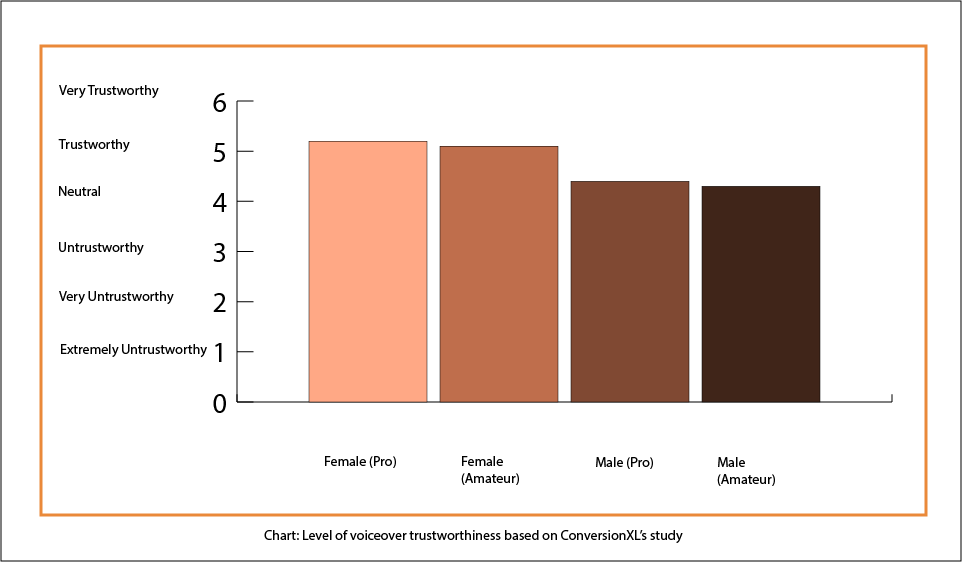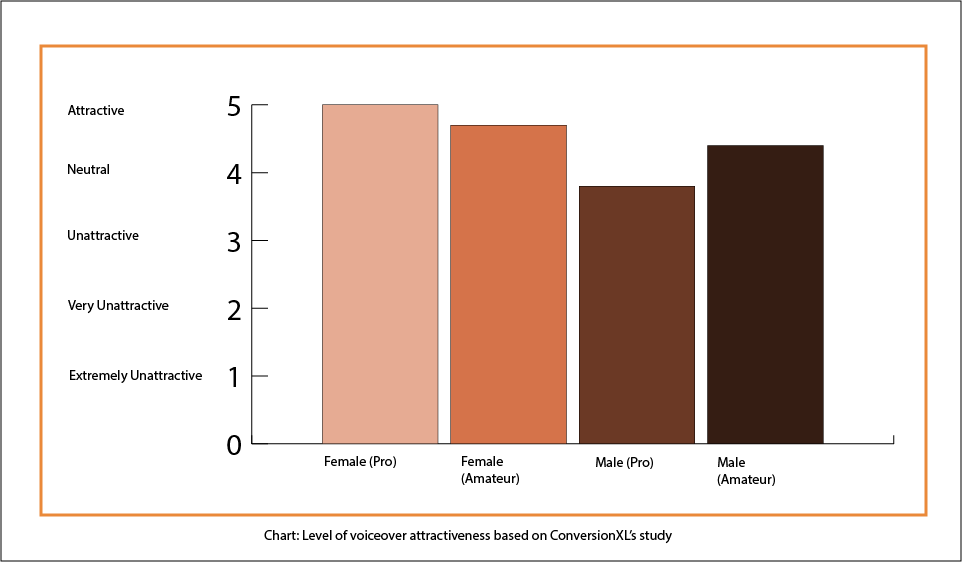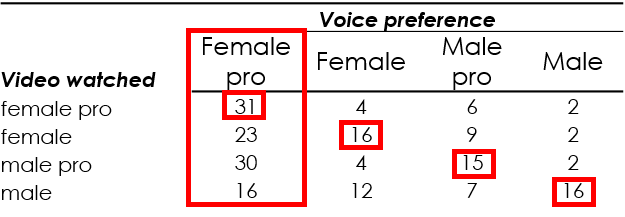We always look for a way to make the final cut of our explainer videos stunning.
The voice-over is one among several ways that can pave the way to that result. A voice-over isn’t merely the narration that goes along with the animation in an explainer video.
A wise choice of voice actors can make a video trustworthy and attractive, while a poor choice of voice actor can degrade a well-made explainer video.
Ultimately, a decision as simple as choosing a male or female voice actor has the potential to alter the messages in an explainer video in terms of clarity, consistency, and effectiveness.
In this article, we’re going to talk about how male and female voice actors can shape how viewers perceive your explainer video.
Key Takeaways: Male vs. Female Voice Actors
- Audience and Message Dependence: The choice between male and female voice-overs is contingent upon the target audience and the intended message of the explainer video. It’s crucial to align the voice-over gender with these elements for maximum impact.
- Female Voice Preferences: Generally, female voices are favored for their emotional depth and intimacy. Studies have shown that people tend to trust higher-pitched voices, which are more common in females, making female voice-overs broadly applicable across various products and services.
- Male Voice Niches: Male voice-overs are particularly effective for products traditionally targeted towards male demographics, such as cars and technology gadgets. They are perceived as more authoritative and are often chosen for content that requires a tone of command or factual delivery.
- Impact on Perception: The voice-over can significantly affect how the explainer video is received. Female voices are generally perceived as more soothing and comforting, potentially making them more effective in building trust. Male voices, however, may be preferred for their perceived forcefulness in certain contexts.
- Enhancement of Engagement and Accessibility: Voice-overs, regardless of gender, play a critical role in clarifying complex concepts, enhancing engagement, adding personality to the video, and making content accessible to a wider audience, including those with visual impairments or non-native speakers.
- Branding and Consistency: The choice of voice-over can contribute to the branding efforts, with consistency in the voice used across marketing materials helping to reinforce brand identity. A unique and memorable voice can distinguish the video and enhance brand recognition.
- Listening to Samples: Before making a decision, it’s beneficial to listen to sample voice-overs from both genders to determine which aligns best with the video’s content, target audience, and desired emotional impact.
Male or Female Voice Actor: What Does Research Say?
ConversionXL researched which type of voice actor to use in one of their explainer videos.
Instead of doing the research by simply comparing male and female voice actors, they added two additional variables: professional and nonprofessional.
So, 4 types of voice actors were tested: professional male, professional female, nonprofessional male and nonprofessional female.
They wanted to find out how “trustworthy” and “attractive” these different voices were perceived as being.
Here’s what they learned from the research:
- In terms of trustworthiness, female voices were stronger than males’ narration of the explainer video as shown in the diagram below.

- The male professional was the least favorite of all four categories.
- Viewers significantly prefer female voicesovers than male voiceovers.
- Whether the female voice actor was professional or nonprofessional did not affect anything significantly.
In another research study featured on the VoiceBunny blog, male and female voices seemed to appeal to different demographics.
They did a head-to-head comparison between male and female voice actors to find out how each of them performed.
What they found from this research follows:
- In terms of forcefulness, 48% of the respondents said that male voices sounded more forceful, while 49% of those surveyed said that sex made no difference.
- 46% of respondents said that female voices were more soothing, while 46% said sex didn’t make any difference.
- 28% of respondents felt that a male voice was “more likely to sell me a car” compared to just 7% who chose a female’s voice.
- 23% also said that a male voice was “more likely to sell me a computer” compared to just 7% who picked a female.
The last two findings from VoiceBunny’s research use products that are often associated with males instead of females. There’s a good chance that the result would be different if the products were lipstick and foundation.
In short, from these two research studies we can conclude that, in terms of viewers’ preferences and perceptions of likability, female voices win, but when it comes to selling for a specific demographic (e.g: car enthusiast), male voices take the lead.
Let’s go to a deeper analysis.
Why Your Audience Prefers Female Voice-Overs: the Analysis
Before we go into the analysis, let’s get one thing out of the way:
Choosing between male and female voice-overs is not a cut-and-dry task. It can only be decided by how you want your explainer video to reach your audience and what message you are going to use.
Again, the demographic of your target market is a major factor that affects whether you should use a male or female voice-over.
Tip: Most of the time, you’ll be better off using a voice-over that corresponds to your audience’s majority gender. But female voices are generally perceived as friendlier by everyone.
A male voice-over is typically utilized for selling products that are aimed at male consumers, and a female voice-over is typically used for products aimed at female consumers.
Male voices are perceived to be more authoritative and commanding than female voices, and most of the time this is the only surefire win that male voice-overs have over female ones.
“Men’s voices are associated with neutrality, with authoritative, factual information,” explains Arthur Chu, a Cleveland-based artist who’s done voice-over work for brands like Safeway and Intel.
“The voiceover you want for some kind of authoritative instructional video, or something asserting dry historical fact, is going to be that baritone, somewhat monotone, slightly stern voice.”
If your product is related to cars, computers, or the newest gadget, then a male voice-over is a good option; that’s typically the audience interested in those products.
Female voiceovers, on the other hand, have been known to sound more intimate and emotional than male voices, but there’s more to female voices than just that.
- Higher pitch: Female voices typically have a higher pitch than males. Psychologist Phil McAleer recorded 64 different people saying “Hello,” and the results showed that female voices were more trustworthy than male voices. High-pitched voices were seen as more trustworthy compared to low-pitched voices because high-pitched voices hint at confidence.
- Comforting nature: A Harris Interactive poll found 46 percent of participants rated female voices as more soothing than male voices. Soothing voices can make people feel comfortable, and when people feel comfortable, they’re more inclined to trust.
- Melodic: The melodic nature of a female voice can also play a role in the trust it instills, as can the fact that female and male voices are processed by different parts of the brain. A University of Sheffield study found female voices are processed by the auditory region of the brain, the same area that processes music. Male voices are processed in the back of the brain in an area known as the “mind’s eye.”
- Emotional: “Because females tend to be the more nurturing gender by nature, their voices are often perceived as a helper, more compassionate, understanding, and non-threatening,” says Debbie Grattan, a veteran voice-over artist for brands like Apple, Samsung, and Wal-Mart.
Here are some insights on why this choice matters:
- Tone Setting: The voice-over establishes the tone of the video. Depending on the message, a more formal tone might be needed, or a playful one could be more effective. Matching the tone to the content helps in creating an emotional connection with the audience, making the message more memorable .
- Message Clarification: Voice-overs play a crucial role in simplifying complex concepts, making them easy to understand. They can enhance engagement and maintain the audience’s focus on the message .
- Adding Personality: The voice in the video can add personality, building trust and credibility. A unique and memorable voice can differentiate the video from others, reinforcing brand identity .
- Gender Preferences in Voice: Studies show that people generally trust female voices more, finding them soothing and comforting. This is particularly effective when the goal is to establish trust in explainer videos. Conversely, male voices are often preferred for products and services traditionally associated with men, like cars or tech gadgets .
- Accessibility Enhancement: A well-executed voice-over can make the content more accessible to a diverse audience, including those with visual impairments or non-native speakers. Clear and articulate voice-overs are crucial for inclusivity .
- Branding: Consistency in the voice used across various marketing materials can enhance branding efforts. A distinctive voice can become part of the brand’s identity .
Choosing between a male or female voice-over should be guided by the content of the video, the target audience, and the desired impact on the viewer.
How Voice-Overs Impact Brand Perception
Voice-overs play a pivotal role in shaping how your brand is perceived by your audience. They go beyond mere narration, embedding emotion, tone, and personality into your messaging.
Here’s how voice-overs influence brand perception:
- Building Trust and Familiarity: A soothing and articulate voice-over can create an emotional connection, making your audience feel understood and valued. Female voices, often associated with trustworthiness and comfort, are especially effective in nurturing customer relationships. Male voices, on the other hand, convey authority and strength, which can be ideal for technical or authoritative brands.
- Differentiating Your Brand: A unique and memorable voice can help your brand stand out in a crowded market. Consistency in voice-overs across marketing materials reinforces brand identity, making your business instantly recognizable.
- Emphasizing Brand Values: The tone and delivery of a voice-over can reflect your brand’s core values. For instance, a playful and lively voice works for a youthful, dynamic brand, while a calm, professional tone suits industries like finance or healthcare.
- Enhancing Storytelling: A well-chosen voice-over brings your brand’s story to life. By matching the voice to your narrative’s mood and audience, you can create a compelling and immersive experience that resonates deeply with viewers.
- Increasing Engagement: Videos with appropriate voice-overs are more engaging and relatable. They humanize your brand, making your messaging more accessible and impactful.
10 Tips for Choosing the Right Voice-Over
Selecting the right voice-over for your brand’s video is a strategic decision that involves balancing audience preferences, brand identity, and message clarity. Here are actionable tips to guide you:
- Understand Your Target Audience: Determine the demographic and preferences of your audience. Female voices tend to be versatile and widely accepted, while male voices excel in delivering authority and technical precision. Match the voice-over gender and tone to your audience’s expectations.
- Align with Your Brand Identity: Ensure the voice-over reflects your brand’s personality. For instance, a luxury brand might opt for a smooth, sophisticated tone, while a tech startup may benefit from a fresh, energetic voice.
- Test Different Styles: Experiment with various voice tones and styles—formal, conversational, energetic, or soothing. Gather feedback from focus groups or surveys to identify which resonates best with your audience.
- Prioritize Clarity and Articulation: Choose a voice-over artist who speaks clearly and enunciates well. This ensures that your message is easily understood, even by non-native speakers or in noisy environments.
- Use Professional Talent: Invest in professional voice-over artists who bring expertise and versatility. Nonprofessional voices may lack the polish and impact needed for professional marketing materials.
- Consider Emotional Impact: The emotional tone of a voice can significantly influence how viewers perceive your brand. For empathetic and comforting messages, female voices work well, while male voices are effective for assertive and motivational content.
- Keep It Consistent: Maintain consistency across all voice-overs in your marketing materials. A consistent voice helps reinforce your brand identity and creates a seamless customer experience.
- Optimize for Accessibility: Ensure the voice-over is easy to understand for a diverse audience, including those with visual impairments. Avoid overly complex diction and ensure the pacing is appropriate.
- Use Samples and Feedback: Always listen to multiple voice-over samples before making a final decision. Share options with your team or trusted audience members to gather feedback and identify the most effective choice.
- Match Voice to Content Type: Tailor the voice-over to the type of content. A tutorial or explainer video might benefit from a calm and instructional tone, while an ad for a new product could require a lively and enthusiastic delivery.
Wrapping Up
Generally, there is no clear-cut answer to which gender you should use for a voice-over because the question is heavily dependent on who your target audience is and what kind of message there is to deliver.
However, data proves that generally female voices are preferred over male voices, and here’s why:
- Female voice-overs are perceived as more emotional and intimate.
- Human brains have evolved to trust high-pitched voices more than lower-pitched ones, and female voices are generally higher-pitched.
- Male voice-overs prove to be more effective for products aimed at males, whereas female voice-overs can apply to virtually any product or service.
Again, this is not to say that male voice-overs are bad for your explainer videos. They can work well if your product is somehow aimed at males.
But the ultimate takeaway is when in doubt, use female voice-overs.
What are your thoughts on female vs. male voice-overs? Let me know below.
Read More:

